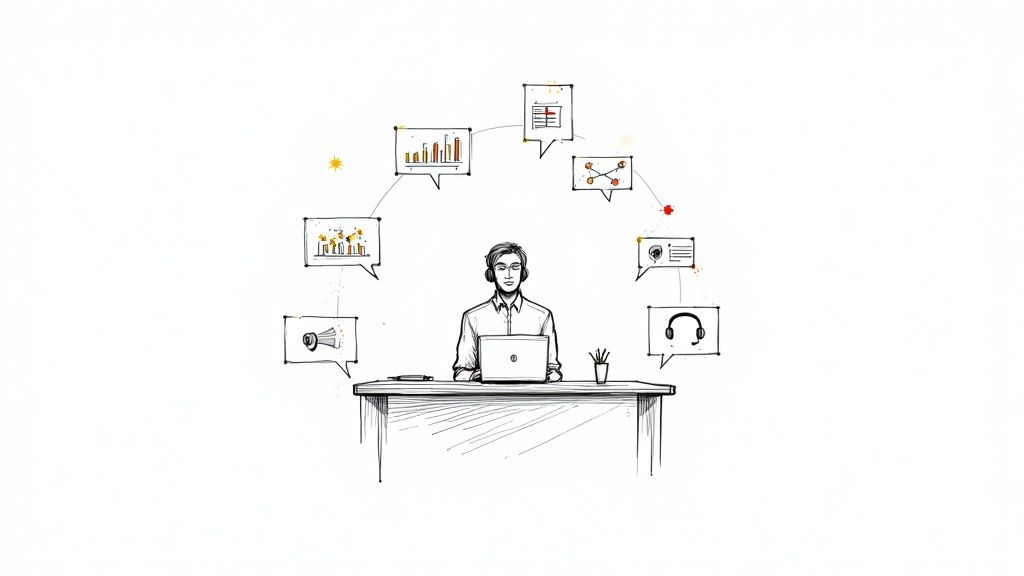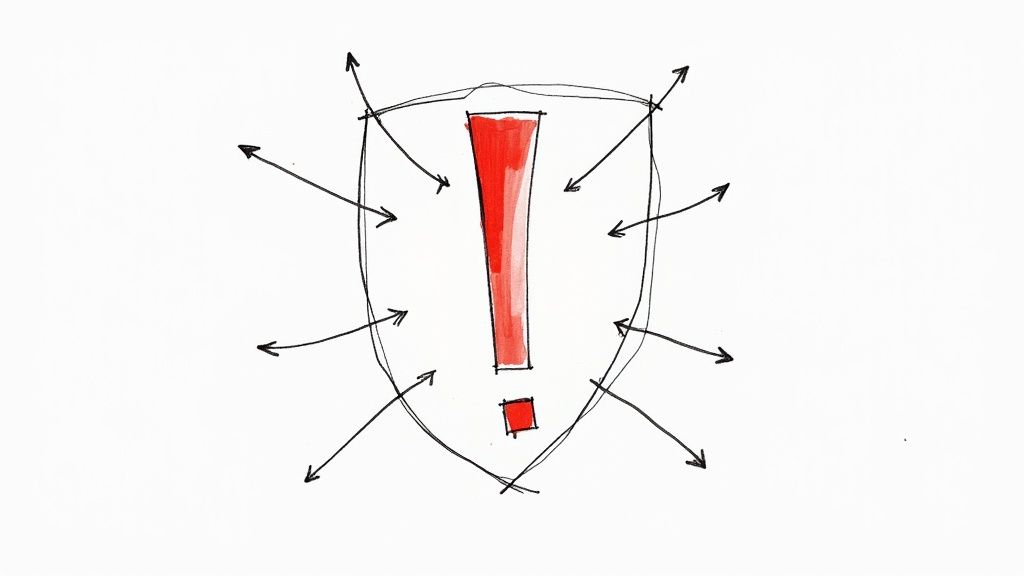August 11, 2025

The role of a community manager has evolved far beyond simply posting updates and counting likes. It’s a strategic position that sits at the intersection of marketing, customer support, and brand management, demanding a unique blend of skills. A great community manager is the architect of a brand’s online ecosystem, tasked with fostering genuine connections, driving meaningful conversations, and ultimately, building a loyal, self-sustaining tribe around a shared purpose. But what does this multifaceted role truly entail day-to-day?
Understanding the full scope of community manager responsibilities is crucial for both aspiring professionals looking to make an impact and for the organizations that hire them. Misunderstanding this role leads to untapped potential and disengaged audiences. This article provides a definitive breakdown of the core duties that define success.
We will explore the 7 essential responsibilities that form the modern community manager's playbook. From content creation and crisis management to performance analytics and strategic growth, you will gain a clear, actionable understanding of what it takes to build, nurture, and scale a thriving community. This guide will equip you with the insights needed to master these functions and demonstrate tangible value.
A core component of a community manager’s responsibilities is to act as the chief storyteller and content architect for the community. This goes far beyond simply posting updates; it's about developing a strategic content plan that fuels engagement, provides tangible value, and reinforces the community's purpose. It involves a dynamic mix of creating original content and curating relevant, high-quality resources from external sources.
The goal is to establish the community as the go-to hub for information, discussion, and resources within its niche. This means understanding the audience's pain points, interests, and motivations to deliver content that resonates deeply. A successful content strategy ensures that every piece of information, whether an original video, a curated article, or a member spotlight, serves a specific purpose in the community's ecosystem.
Without a steady stream of valuable content, a community can quickly become stagnant. Members lose their reason to return, conversations dwindle, and the platform fails to achieve its business objectives. Strategic content creation is the engine that drives daily interaction and long-term member retention. It's the tangible evidence of the value your community provides.
Key Insight: Think of your content calendar not as a list of posts, but as a curriculum designed to educate, inspire, and connect your members. Every piece should contribute to a larger narrative about your brand and the value it offers.
One of the biggest challenges in content management is ensuring members can easily find what they need. Juggling content across different platforms, like a separate blog, a video host, and a document library, creates a fragmented user experience. GroupOS solves this by centralizing all your valuable resources within a single, branded community space. You can share documents, host on-demand courses, and stream videos directly within the platform. This streamlined approach makes content discovery effortless for members and simplifies one of the most vital community manager responsibilities.
If content is the engine, then engagement is the fuel that keeps a community running. This crucial responsibility involves actively participating in the life of the community by responding to comments, facilitating discussions, and acknowledging member contributions. It's the human element of community management, transforming a static platform into a vibrant, living ecosystem where members feel seen, heard, and valued.

This goes beyond simple moderation; it's about proactively fostering meaningful conversations and building genuine relationships. When a community manager actively engages, they set the tone for the entire community, encouraging a culture of reciprocity and mutual respect. This active presence is what makes members feel like they are part of a real group, not just users on a platform.
A community without active engagement is like a party with no host. Members might show up, but without someone to spark conversations and make introductions, they'll quickly grow bored and leave. Consistent interaction signals that the community is active and that member participation matters. This is one of the most vital community manager responsibilities for building loyalty and preventing member churn.
Key Insight: Every interaction is an opportunity to reinforce a member's decision to join. Think of yourself as the community's chief relationship officer, whose primary job is to ensure every member feels a strong sense of belonging.
Managing conversations across numerous posts and threads can be overwhelming. It's easy to miss important comments, leading to members feeling ignored. GroupOS centralizes all community activity into an intuitive dashboard, providing a clear overview of new posts, comments, and member interactions. With features like threaded discussions and direct messaging, you can easily track conversations and respond promptly from one place. This ensures no member voice is lost, allowing you to focus on building quality relationships instead of hunting for notifications.
One of the most immediate and visible community manager responsibilities is serving on the front lines of customer support. In the public square of social media and community forums, members and customers will inevitably voice concerns, ask questions, and report issues. The community manager acts as the first point of contact, a brand ambassador who can provide timely, empathetic, and effective solutions. This involves more than just answering questions; it's about actively listening to user frustrations, troubleshooting problems, and managing brand reputation in real-time.
This role requires a unique blend of technical knowledge, patience, and communication skill. The goal is to resolve issues quickly and publicly when appropriate, demonstrating the brand's commitment to customer satisfaction. For more complex or sensitive matters, the community manager must efficiently escalate the problem to the correct internal department, ensuring a seamless experience for the user. Think of this function as the human face of your support system, turning potentially negative interactions into opportunities to build loyalty and trust.
In a digital world, a single unresolved complaint can quickly escalate and damage brand perception. Proactive and efficient customer support within the community is not just a reactive measure; it's a powerful tool for retention and advocacy. When members see that their problems are heard and addressed, it reinforces their trust in the organization. Neglecting this function can lead to a community filled with unanswered questions and public complaints, actively deterring new members and frustrating existing ones.
Key Insight: Treat every support inquiry as an opportunity to showcase your brand's values. A well-handled complaint can create a more loyal advocate than a customer who never had a problem at all.
Handling support requests across multiple channels creates confusion and slows down response times. A key part of this community manager responsibility is creating a centralized, efficient system. GroupOS consolidates member interactions into one platform, making it easy to track and manage support tickets. You can create dedicated "Help" or "Support" channels where members can post questions. With all member data and communication history in one place, you can quickly understand a user's context and provide more effective, personalized support without having to switch between different tools.
A community manager acts as the primary guardian of the brand's persona within the community. This responsibility involves more than just communication; it's about embodying the brand's voice, personality, and values in every interaction. From the tone of a welcome message to the handling of a sensitive complaint, the community manager ensures all communication is consistent and aligns with the established brand identity. This consistency builds trust and makes the brand feel relatable and human.
Beyond shaping the brand’s voice, this role includes vigilant reputation management. This means actively monitoring conversations, addressing negative feedback constructively, and proactively managing the brand's image. A community manager is on the front lines, turning potential PR crises into opportunities for demonstrating transparency and commitment to member satisfaction. This dual focus on voice and reputation is a cornerstone of effective community management.
A brand's reputation is one of its most valuable assets, and an online community is a powerful amplifier of public perception, for better or worse. Inconsistent messaging can confuse members and dilute brand identity, while unaddressed negative feedback can quickly spiral, damaging trust. Proactive reputation management is essential for maintaining a healthy, positive environment where members feel heard and respected, solidifying the brand’s credibility in its industry.
Key Insight: Your brand's voice isn't just what you say; it's how you make people feel. Treat every interaction as an opportunity to reinforce your brand's core values and build a stronger, more authentic relationship with your members.
Managing brand reputation requires a centralized view of all member interactions and a secure space for communication. When conversations are scattered across social media, email, and various chat apps, it's impossible to maintain a consistent voice or track sentiment effectively. GroupOS consolidates all community activity into a single, private platform. This controlled environment allows you to manage discussions, address concerns directly, and ensure every communication aligns with your brand’s voice. This level of control is crucial for one of the most sensitive community manager responsibilities, and you can explore more details in our complete online community manager job description.
Beyond facilitating conversations and creating content, a critical community manager responsibility is to measure the impact of these efforts. This involves tracking, analyzing, and reporting on key community metrics such as engagement rates, member growth, and content performance. It’s the science behind the art of community building, transforming abstract feelings of "community health" into concrete data that demonstrates value and informs strategic decisions.

This process allows the community manager to understand what resonates with members, identify emerging trends, and prove the community's return on investment (ROI) to key stakeholders. By using analytics tools, they can answer crucial questions: Which content formats drive the most discussion? What are the peak activity times for our members? How does community engagement correlate with member retention or sales? This data-driven approach moves community management from a "nice-to-have" function to an essential business driver.
Without robust analytics and reporting, a community manager is essentially flying blind. It's impossible to justify resources, optimize strategies, or demonstrate growth if you can't measure it. Data provides the necessary evidence to advocate for the community's needs and showcase its contribution to broader business objectives, like customer loyalty, lead generation, or product innovation. This is a fundamental aspect of professionalizing the role of a community manager.
Key Insight: Data tells a story. Your job as a community manager is not just to collect numbers, but to translate that data into a compelling narrative about your community's health, impact, and potential.
One of the biggest hurdles in community analytics is consolidating data from disparate sources and presenting it clearly. Tracking engagement on one platform, membership growth in a spreadsheet, and event attendance in another tool is inefficient and leads to an incomplete picture. GroupOS integrates powerful analytics directly into your community hub. You can monitor member activity, track content engagement, and view growth trends from a single, intuitive dashboard. This centralization of data makes regular reporting seamless and empowers you to make smarter, faster decisions to enhance your community's success.
A community manager's responsibilities extend beyond maintaining the current member base; they are also the primary architects of growth. This involves developing and executing a multi-faceted strategy to attract new, high-quality members who align with the community's purpose and values. This isn't just about increasing numbers, but about scaling the culture and engagement in a sustainable way.
Effective growth requires a deep understanding of the target audience, identifying where they congregate online, and creating compelling reasons for them to join. From referral programs and influencer partnerships to strategic outreach, the community manager orchestrates campaigns that expand the community's reach and influence. This responsibility ensures the community remains dynamic, avoids stagnation, and continually injects fresh perspectives into the conversation.
A community without a growth strategy is a community with an expiration date. Natural churn is inevitable, and without a proactive plan to attract new members, the group will slowly shrink and lose its vitality. A thoughtful growth plan ensures long-term viability, increases the diversity of thought and experience within the group, and expands the brand's overall market presence. It transforms the community from a static resource into a growing, evolving ecosystem.
Key Insight: Treat community growth like a flywheel, not a faucet. Instead of short-term campaigns that you turn on and off, build self-sustaining loops like referral programs and high-value content that naturally attract new members over time.
Managing growth campaigns, tracking referrals, and onboarding new members can quickly become a logistical nightmare spread across spreadsheets and emails. This is another area where a community manager’s responsibilities can be streamlined. GroupOS provides a centralized platform to manage the entire member lifecycle, from acquisition to long-term engagement. With its integrated tools, you can easily create exclusive access tiers for new member cohorts, track sign-ups from specific campaigns, and automate the onboarding process. This allows you to focus on strategy rather than getting lost in administrative tasks. Learn more about powerful Community Building and Growth Strategies on groupos.com.
One of the most high-stakes community manager responsibilities is acting as the first line of defense during a crisis. This involves navigating negative situations, from member disputes and heated arguments to public relations crises that threaten brand reputation. It requires developing protocols for identifying, assessing, and responding to issues swiftly and effectively, often coordinating with legal, PR, and leadership teams to ensure a unified and responsible message.
A community manager must be prepared to handle escalated complaints and potential damage to the brand's image with a calm, strategic approach. This isn't just about putting out fires; it's about protecting the community's integrity and trust. From a single user's serious complaint to a widespread service outage, the community manager's response sets the tone for how the organization is perceived.

In the digital age, a minor issue can escalate into a major brand crisis within minutes. A poor or slow response can erode years of community trust and lead to significant reputational and financial damage. Effective crisis management demonstrates accountability, reinforces brand values, and can even strengthen community loyalty by showing members that the organization cares and is responsive in difficult times.
Key Insight: A crisis plan is not a "what if" document; it's a "when it happens" guide. The goal is not to prevent all problems, but to have a robust, predictable system for managing them when they inevitably arise.
During a crisis, communicating with the right people at the right time is paramount. Relying on scattered emails or public social media can lead to misinformation and confusion. GroupOS provides a secure, centralized communication hub where you can manage sensitive situations effectively. You can create private, dedicated channels for your crisis response team to coordinate actions and messaging away from the public eye. Furthermore, its direct messaging and notification tools allow you to communicate with specific affected members or the entire community with targeted, controlled updates, ensuring that one of the most stressful community manager responsibilities is handled with precision and control.
As we have explored, the modern list of community manager responsibilities is far more extensive and strategic than ever before. This role is not merely about posting content or responding to comments; it is the central nervous system of your organization’s member experience. From meticulously crafting content and moderating discussions to analyzing performance data and managing crises, a community manager wears multiple hats, often simultaneously. They are the strategist, the creator, the supporter, and the guardian of your brand's voice.
The journey through these core duties, including content creation, member engagement, and growth strategies, reveals a crucial truth: these tasks are deeply interconnected. A successful growth initiative is fueled by compelling content, which in turn drives engagement. That engagement generates valuable data for analytics, and effective reputation management ensures the entire ecosystem remains healthy and positive. Attempting to manage these intertwined functions with a patchwork of separate, disconnected tools is a recipe for inefficiency, burnout, and a fragmented member journey.
The ultimate goal is to transform this complex set of responsibilities from a reactive, task-based checklist into a proactive, unified strategy. This shift is impossible when critical information is siloed across different platforms, a spreadsheet for member data, a separate tool for email, another for events, and yet another for community discussion. This fragmentation forces community managers to spend more time juggling software and less time building relationships.
To truly empower your community leader, you must provide them with a centralized hub where all these functions converge. A unified platform eliminates the friction of switching between tools, provides a single source of truth for member data, and offers a holistic view of community health. This integrated approach allows a community manager to seamlessly transition from publishing a new resource to announcing an event, analyzing engagement trends, and directly addressing member feedback, all within one ecosystem.
To master the diverse community manager responsibilities, focus on these pivotal takeaways:
By implementing a cohesive strategy supported by integrated technology, you enable your community manager to move beyond day-to-day tasks and become a true driver of organizational growth, retention, and brand loyalty. This is how you unlock the full potential of your community and the professional leading it.
Ready to consolidate your community manager responsibilities into a single, powerful platform? GroupOS provides an all-in-one solution designed to streamline event management, content delivery, and member engagement, empowering your team to build a thriving community with unparalleled efficiency. Discover how GroupOS can transform your community strategy today.


